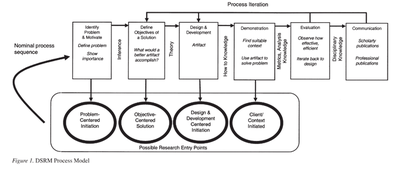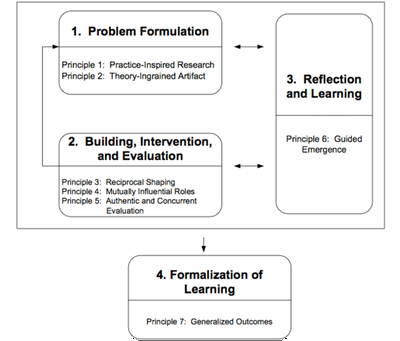DSR Approach Models
Which DSR approach models exist and what distinguishes them?
Edited by Pia Gebbing and Jannes Menck
Design Science Research (DSR) emphasizes two fundamental aspects in its approach: rigor and relevance. Specifically, this means anchoring design knowledge and the approach models in well-founded theories and scientifically recognized methodologies (A. R. Hevner, 2021). The design cycles according to Hevner (2007) also reflect this logic by deliberately linking descriptive knowledge (e.g., from established theories) with prescriptive knowledge (e.g., from expert interviews). Based on these fundamental assumptions of the DSR approach (Gregor, 2002; A. Hevner, 2007; A. R. Hevner et al., 2004), various approach models have been developed to methodically and substantively structure the research. The goal is to effectively and efficiently carry out the design, implementation, analysis, management, and use of information systems (IS) (Hevner et al., 2004). In contrast to the established concept of DSR cycles, however, there are (still) no universally accepted approaches but a multitude of approach models. While some models are gradually gaining acceptance and being replicated (Kuechler & Vaishnavi, 2012; Peffers et al., 2007), many authors develop their own approaches that fit their research projects (e.g., Wambsganss et al., 2021). Other prior models from related disciplines, such as Action Design Research, can be easily adapted to the theoretical foundations of DSR.
Commonalities of Different Approach Models
Since the different approaches are usually based on the model of DSR cycles, there are often significant commonalities:
- Iteration: DSR is generally considered a multi-step, iterative process in which one dynamically switches between the three cycles (Relevance Cycle, Design Cycle, and Rigor Cycle).
- From Problem to Solution: The process always begins with identifying a question that addresses a relevant, real problem (Möller et al., 2020).
- Generation of Design Knowledge: Design knowledge is generated by linking prescriptive knowledge (e.g., through expert interviews) and descriptive knowledge (based on existing theories).
Differences of Different Approach Models
However, the approach models differ particularly in two aspects:
- Granularity: Some authors divide the process into more steps than others.
- Focus: The distinction between prescriptive and descriptive knowledge is emphasized to varying degrees.
In the following, three exemplary approach models are described, which partly build on each other but also have different focuses and granularities.
1. Kuechler and Vaishnavi 2019
The approach model by Kuechler and Vaishnavi is based on a method by Takeda et al. (1990). The goal is the refinement of a kernel theory (LINK), mid-range theory, or a design theory. The steps presented are:
Understanding the Problem: A problem can come from various areas, such as industry or another discipline. For DSR, solution-oriented problems are particularly relevant. For understanding the problem, criteria should be sought with which a solution can be evaluated. The result of the phase should be a proposal for a new scientific approach.
Proposing a Solution: Based on the proposal, a solution proposal should be developed. Here, a new functionality is suggested and further developed into a preliminary design sketch. If no solution proposal is found, the proposal from step one is discarded.
Developing the Solution: If a design sketch could be developed, it is implemented in an artifact (Link) in the next step. Depending on the type of artifact, different types of implementation are possible. In the implementation, it is not of great importance how novel the construction of the artifact is. The novelty of the design is paramount.
Evaluating the Solution: After the artifact has been developed, it can be evaluated with the metrics found in step one. Deviations from these should be recorded and justified. It is possible to formulate hypotheses about the expected results and investigate them. The gain in knowledge in this step is of central importance. The results of the evaluation, together with insights gained during development and possible execution, can now be summarized in a new proposal, and the process starts over.
Consolidation of Learning: If the evaluation shows that the artifact satisfactorily solves the problem, the consolidation of the findings can begin. In addition to summarizing the results of the project, the collected (design) knowledge should especially be communicated.

2. Peffers et al. 2007
Peffers et al. (2007) present an approach model that also starts with the identification of a problem to be solved. The problem should be defined, and its relevance demonstrated. Based on the problem, it should be defined what goal a solution to the problem should have (meta-requirements). These can be qualitative or quantitative, depending on the problem. In the next step, an artifact (reference to artifact) should be created in which the scientific contribution is embedded. The desired functionality and architecture of the artifact must also be defined, taking theoretical knowledge into account.
The benefit arising from the artifact concerning a (partial) problem should then be demonstrated. For example, simulations, experiments, case studies, or other approaches can be chosen for the demonstration. This requires knowledge of how the problem can be solved with the artifact. For an evaluation of the artifact, it should be observed during the demonstration, and if possible measured, how well the artifact solves the problem. In this step, the initially defined goals should be compared with the observation results. Depending on the result of the comparison, one can return to the development step or proceed with communication. In communication, the artifact as well as the problem and its importance should be addressed and presented to the professional community. For the artifact, novelty, usefulness, and effectiveness for other researchers and practitioners must be justified. Knowledge about the discipline is necessary for communication. Even if the process is presented largely linearly, it is possible to go back at any time. It is also possible to start at any step if initial approaches already exist on which to build.

3. Action Design Research (ADR)
The approach of Action Design Research (ADR) is recognized as an important variant of the Design Science Research approach and has been used by a number of scientists as a methodological foundation for dissertations and multidisciplinary research projects (Haj-Bolouri et al., 2017). The phases and principles of ADR depicted in Figure XY describe action-oriented research motivated by real-world problems in a real organizational context. The solution is designed through the building, intervention, and evaluation of artifact prototypes within the organizational environment. An important feature of the ADR approach is the underlying participatory philosophy, which states that during all ADR phases and solution development, the entire ADR team is actively involved (researchers, stakeholders, practitioners, end-users) (Haj-Bolouri et al., 2017).

4. Example of Developing One’s Own Approach Model according to Wambsganß (2021)
Since the DSR approach is a relatively young phenomenon, there are no uniform regulations for approach models yet. Most publications therefore develop their own methodology, which they link with the theory of DSR. As a result, the aforementioned commonalities and differences also apply to the self-developed approach models. The following example shows clear similarities to the already described approach models.
Step 1 - Identification of a relevant problem
Step 2 – Descriptive Knowledge
The second step is the acquisition of descriptive knowledge, e.g., through literature analyses, to anchor the design in rigorous scientific findings (Hevner, 2021).
Step 3 – Prescriptive Knowledge
Descriptive knowledge about specific design requirements is generated from expert interviews in the form of user stories.
Step 4 - Derivation of Preliminary Design Knowledge
Development of design knowledge that represents artifacts at different levels.
Step 5 - Validation of Design Principles
The artifacts are tested and validated, e.g., through expert feedback (interviews, workshops), instantiation, or argumentation (Möller et al., 2020).
References
- Gregor, S. (2002). Design Theory in Information Systems
- Haj-Bolouri, A., Purao, S., Rossi, M., & Bernhardsson, L. (2017). Action Design Research as a Method-in-Use: Problems and Opportunities
- Hevner, A. (2007). A Three Cycle View of Design Science Research
- Hevner, A. R. (2021). The Duality of Science: Knowledge in Information Systems Research
- Hevner, A. R., March, S. T., Park, J., & Ram, S. (2004). Design Science in Information Systems Research
- Kuechler, W., & Vaishnavi, V. (2012). A Framework for Theory Development in Design Science Research: Multiple Perspectives
- Möller, F., Guggenberger, T. M., & Otto, B. (2020). Towards a Method for Design Principle Development in Information Systems
- Peffers, K., Tuunanen, T., Rothenberger, M. A., & Chatterjee, S. (2007). A Design Science Research Methodology for Information Systems Research
- Sein, M. K., Henfridsson, O., Purao, S., Rossi, M., & Lindgren, R. (2011). Action Design Research
- Wambsganss, T., Höch, A., Zierau, N., & Söllner, M. (2021). Ethical Design of Conversational Agents: Towards Principles for a Value-Sensitive Design